

Compact Muon Solenoid
LHC, CERN
| CMS-PAS-SUS-17-004 | ||
| Combined search for electroweak production of charginos and neutralinos in pp collisions at $\sqrt{s} = $ 13 TeV | ||
| CMS Collaboration | ||
| August 2017 | ||
| Abstract: A statistical combination of several searches for the electroweak production of charginos and neutralinos is presented. All searches use 35.9 fb$^{-1}$ of proton-proton collisions at $\sqrt{s}= $ 13 TeV recorded by CMS in 2016. In addition to previously performed searches, an optimized analysis requiring three or more charged leptons (electrons or muons) is presented, targeting the challenging scenario where the difference in mass between the two least massive neutralinos is approximately equal to the mass of the Z boson. The results are interpreted in simplified models of supersymmetric chargino-neutralino or neutralino pair production. When the lightest neutralino is massless in the chargino-neutralino model, the combined result obtains an observed (expected) limit at the 95% confidence level in the chargino mass of up to 650 (570) GeV in the most favorable scenario, improving upon the exclusion limits from individual analyses by up to 40 GeV. If the mass difference between the two least massive neutralinos is approximately equal to the mass of the Z boson in the chargino-neutralino model, the optimized search for three or more leptons obtains observed and expected exclusion limits of around 225 GeV in the second neutralino mass and 125 GeV in the lightest neutalino mass, improving the observed limit by as much as 60 GeV compared to the previously published result. In the neutralino pair production model, the observed (expected) exclusion limits from the combined result extends up to 650-750 (550-750) GeV depending on the branching fraction assumed, extending the observed exclusion achieved by individual analyses by up to 200 GeV. The combined result additionally excludes some intermediate gaps in the mass coverage of individual analyses. | ||
|
Links:
CDS record (PDF) ;
inSPIRE record ;
CADI line (restricted) ;
These preliminary results are superseded in this paper, JHEP 03 (2018) 160. The superseded preliminary plots can be found here. |
||
| Figures & Tables | Summary | Additional Figures | References | CMS Publications |
|---|
|
Additional information on efficiencies needed for reinterpretation of these results are available here. Additional technical material for CMS speakers can be found here |
| Figures | |

png pdf |
Figure 1:
Chargino-neutralino pair production with the chargino decaying to the W boson and the LSP and the neutralino decaying to either (left) a Z boson and the LSP or (right) a H boson and the LSP. |
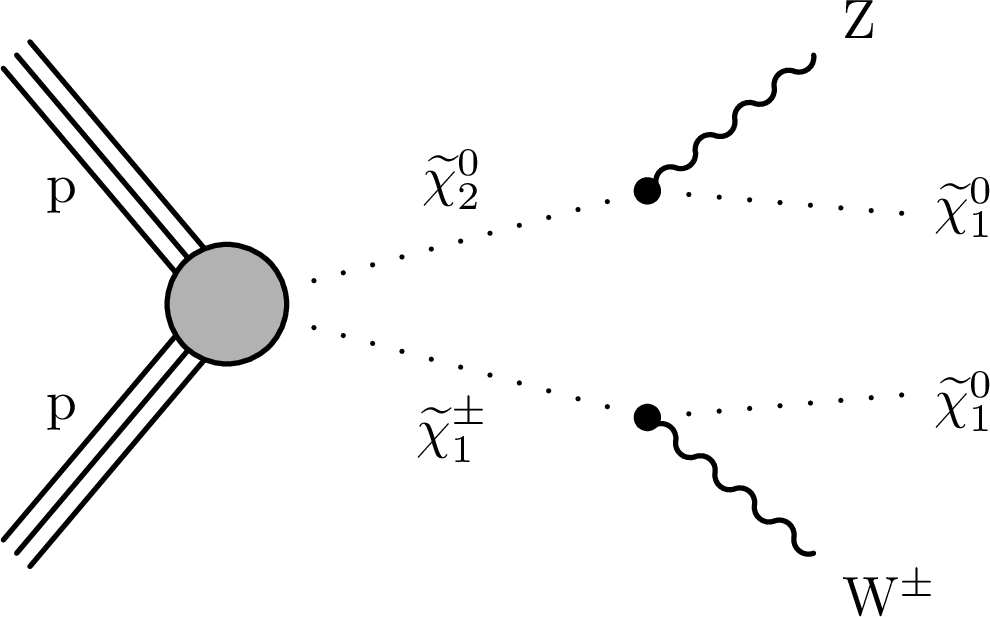
png pdf |
Figure 1-a:
Chargino-neutralino pair production with the chargino decaying to the W boson and the LSP and the neutralino decaying to a Z boson and the LSP. |

png pdf |
Figure 1-b:
Chargino-neutralino pair production with the chargino decaying to the W boson and the LSP and the neutralino decaying to a H boson and the LSP. |

png pdf |
Figure 2:
A GMSB model with neutralino-neutralino pair production and the neutralinos decaying into gravitinos and (left) two Z bosons, (center) a Z and a H boson, or (right) two H bosons. |
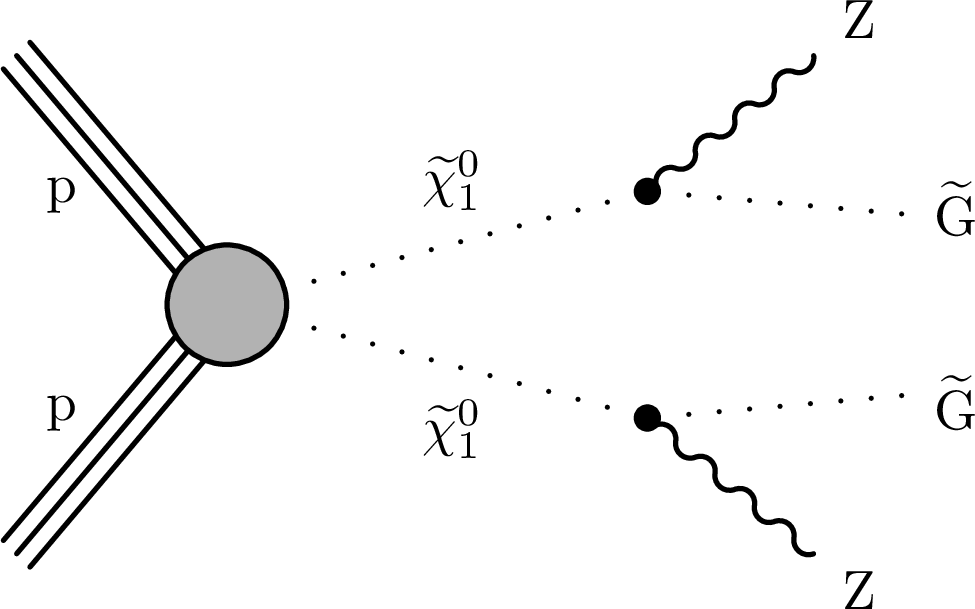
png pdf |
Figure 2-a:
A GMSB model with neutralino-neutralino pair production and the neutralinos decaying into gravitinos and two Z bosons. |

png pdf |
Figure 2-b:
A GMSB model with neutralino-neutralino pair production and the neutralinos decaying into gravitinos and a Z and a H boson. |
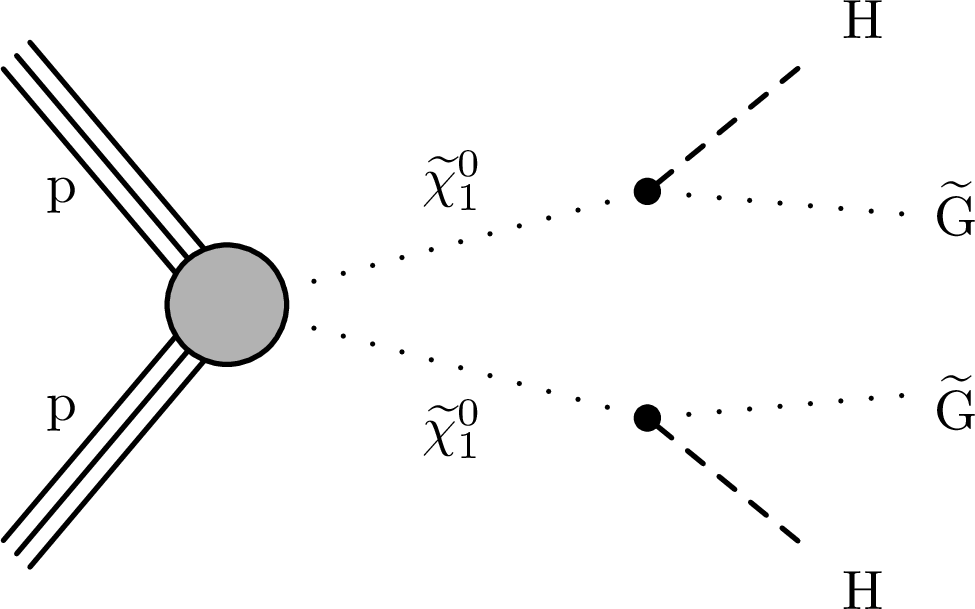
png pdf |
Figure 2-c:
A GMSB model with neutralino-neutralino pair production and the neutralinos decaying into gravitinos and two H bosons. |
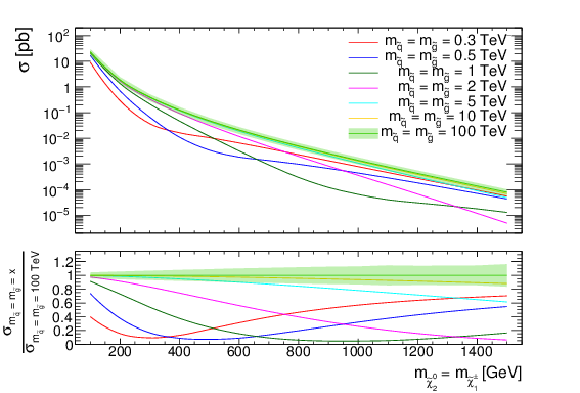
png pdf |
Figure 3:
Cross section for $\tilde{\chi}^{\pm}_1 \tilde{\chi}^0_2 $ production at $\sqrt {s} = $ 13 TeV versus the wino mass, assuming mass-degenerate wino $\tilde{\chi}^{\pm}_1$ and $ \tilde{\chi}^0_2 $. The various curves show different assumptions on the masses of the squarks and gluinos, as described in the legend. The green band shows the theoretical uncertainty in the cross section calculation for the 100 TeV squark and gluino mass assumption. |
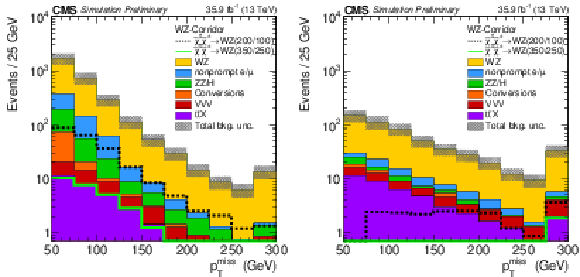
png pdf |
Figure 4:
Distributions of $ {{p_{\mathrm {T}}} ^\text {miss}} $ for two representative signal points in the WZ corridor as well as the expected SM background for $ {H_{\mathrm {T}}} < $ 100 (left) and $ > $ 200 GeV (right). For larger values of $ {H_{\mathrm {T}}} $ the shape difference between signal and background becomes more pronounced due to the presence of the LSPs. |
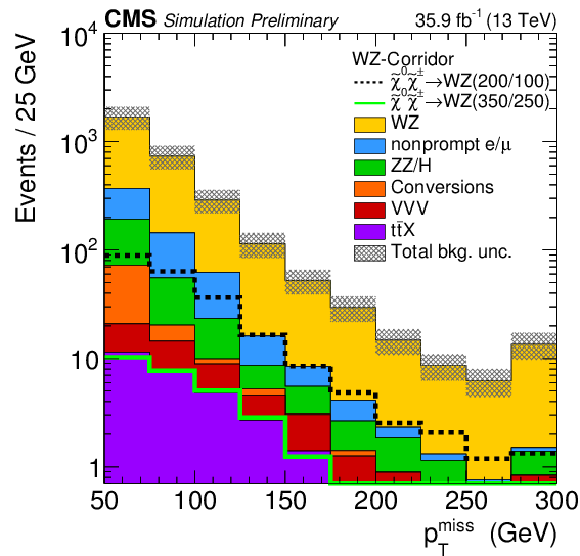
png pdf |
Figure 4-a:
Distributions of $ {{p_{\mathrm {T}}} ^\text {miss}} $ for two representative signal points in the WZ corridor as well as the expected SM background for $ {H_{\mathrm {T}}} < $ 100 GeV. For larger values of $ {H_{\mathrm {T}}} $ the shape difference between signal and background becomes more pronounced due to the presence of the LSPs. |
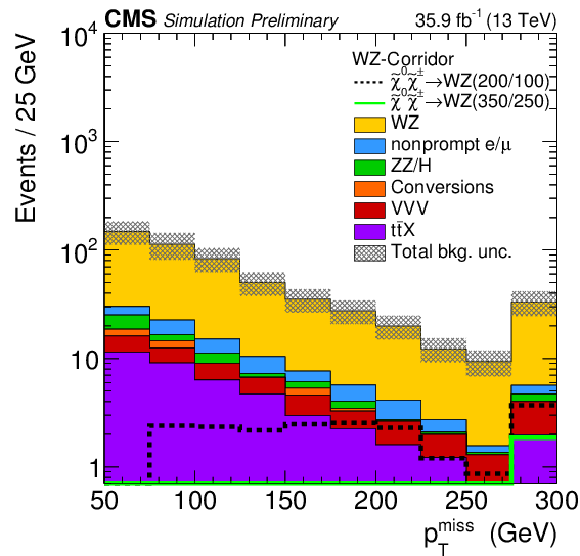
png pdf |
Figure 4-b:
Distributions of $ {{p_{\mathrm {T}}} ^\text {miss}} $ for two representative signal points in the WZ corridor as well as the expected SM background for $ {H_{\mathrm {T}}} > $ 200 GeV. For larger values of $ {H_{\mathrm {T}}} $ the shape difference between signal and background becomes more pronounced due to the presence of the LSPs. |
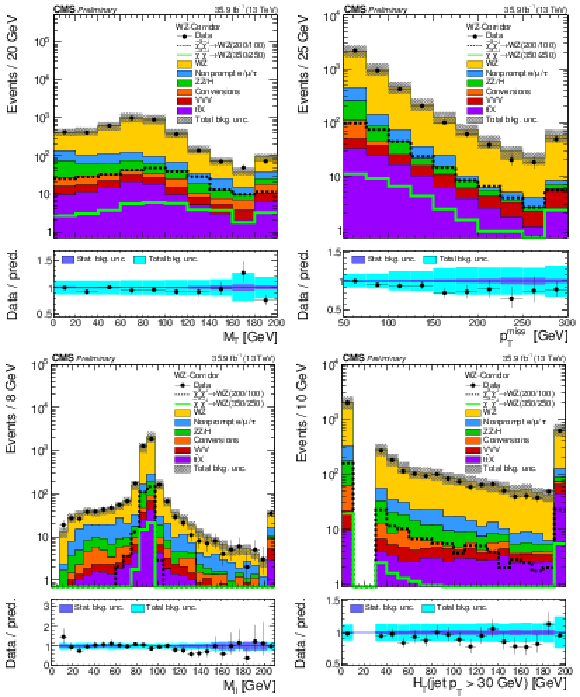
png pdf |
Figure 5:
Distributions of the transverse mass of the third lepton (top left), the $ {{p_{\mathrm {T}}} ^\text {miss}} $ (top right), the $ {m_{\ell \ell}} $ of the OSSF pair (bottom left), and the $ {H_{\mathrm {T}}} $ (bottom right). Distributions for two signal mass points in the WZ corridor are overlaid for illustration. |
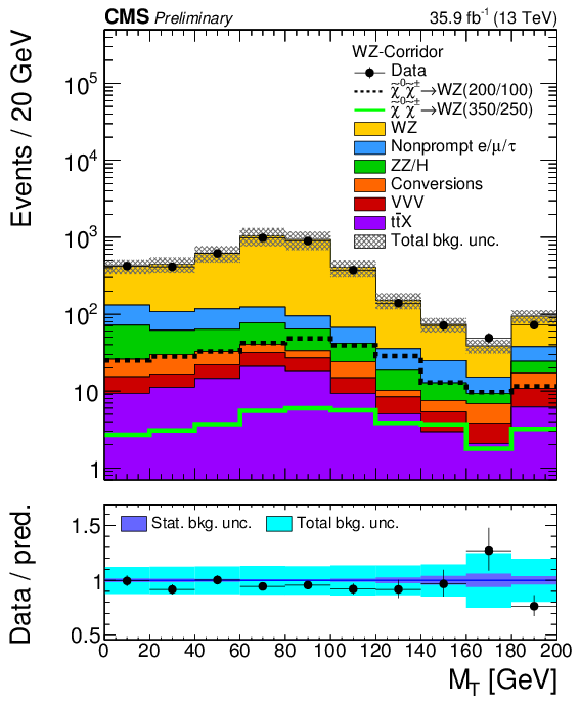
png pdf |
Figure 5-a:
Distributions of the transverse mass of the third lepton. Distributions for two signal mass points in the WZ corridor are overlaid for illustration. |
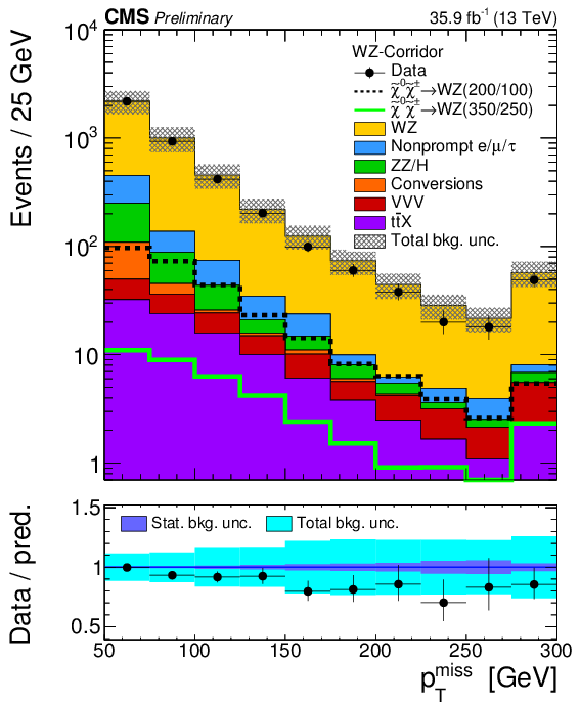
png pdf |
Figure 5-b:
Distributions of the transverse mass of the $ {{p_{\mathrm {T}}} ^\text {miss}} $. Distributions for two signal mass points in the WZ corridor are overlaid for illustration. |

png pdf |
Figure 5-c:
Distributions of the transverse mass of the $ {m_{\ell \ell}} $ of the OSSF pair. Distributions for two signal mass points in the WZ corridor are overlaid for illustration. |
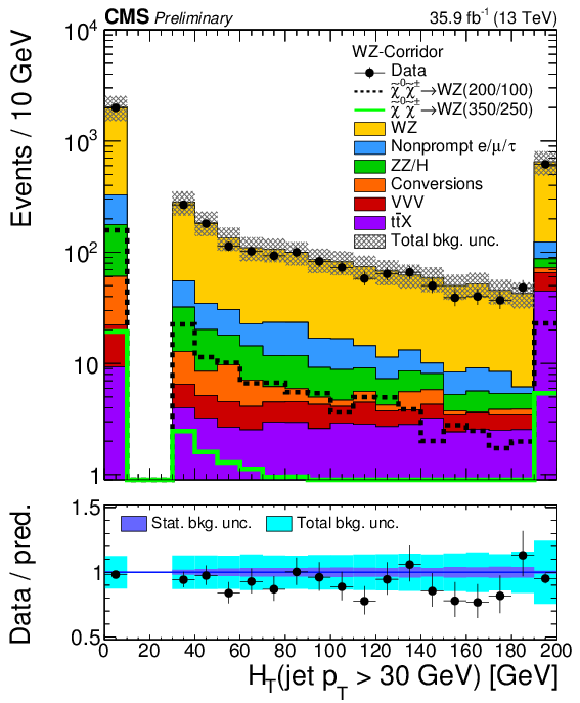
png pdf |
Figure 5-d:
Distributions of the transverse mass of the $ {H_{\mathrm {T}}} $. Distributions for two signal mass points in the WZ corridor are overlaid for illustration. |
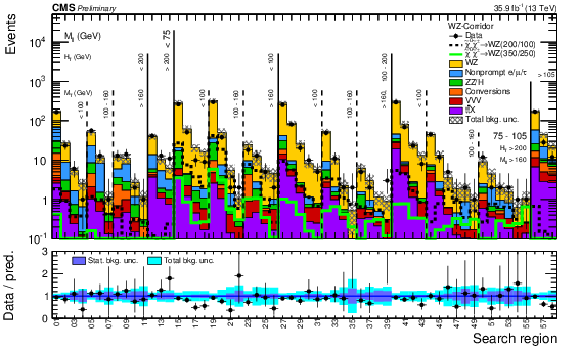
png pdf |
Figure 6:
Expected and observed yield comparison in the search regions. Two example signal mass points along the WZ corridor are overlaid for illustration. |
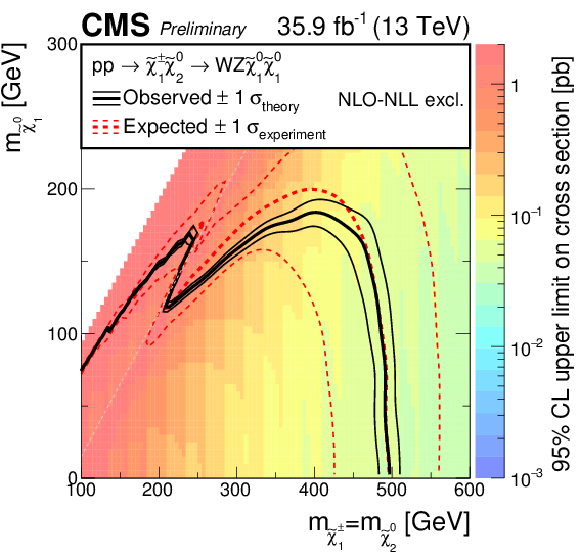
png pdf root |
Figure 7:
The 95% CL upper limit on the production cross section in the plane of $ {m_{\tilde{\chi}^{\pm}_1}} $ and $ {m_{\tilde{\chi}^0_1}} $ for the model of $ {\tilde{\chi}^{\pm}_1 \tilde{\chi}^0_2 } $ production with the WZ topology, using only the search requiring three or more leptons as described in Section 6. The thick solid black (dashed red) curve represents the observed (expected) exclusion contour assuming the theory cross sections. The area below each curve is the excluded region. The thin dashed red line indicates the $ \pm 1 \sigma _{\mathrm {experiment}}$ uncertainty. The thin black lines show the effect of the theoretical uncertainties ($ \pm 1 \sigma _{\mathrm {theory}}$) on the signal cross section. The $z$ axis shows the observed limit at 95% CL on the signal production cross section. |

png pdf |
Figure 8:
The 95% CL upper limits on the production cross sections in the plane of $ {m_{\tilde{\chi}^{\pm}_1}} $ and $ {m_{\tilde{\chi}^0_1}} $ for the models of $ {\tilde{\chi}^{\pm}_1 \tilde{\chi}^0_2 } $ production with (top) the WZ topology, (middle) the WH topology, or (bottom) the mixed topology with 50% branching fraction to each of WZ and WH. The thick solid black (dashed red) curve represents the observed (expected) exclusion contour assuming the theory cross sections. The area below each curve is the excluded region. The thin dashed red line indicates the $ \pm 1 \sigma _{\mathrm {experiment}}$ uncertainty. The thin black lines show the effect of the theoretical uncertainties ($ \pm 1 \sigma _{\mathrm {theory}}$) on the signal cross section. The $z$ axis shows the observed limit at 95% CL on the signal production cross section. |

png pdf root |
Figure 8-a:
The 95% CL upper limits on the production cross sections in the plane of $ {m_{\tilde{\chi}^{\pm}_1}} $ and $ {m_{\tilde{\chi}^0_1}} $ for the models of $ {\tilde{\chi}^{\pm}_1 \tilde{\chi}^0_2 } $ production with the WZ topology. The thick solid black (dashed red) curve represents the observed (expected) exclusion contour assuming the theory cross sections. The area below each curve is the excluded region. The thin dashed red line indicates the $ \pm 1 \sigma _{\mathrm {experiment}}$ uncertainty. The thin black lines show the effect of the theoretical uncertainties ($ \pm 1 \sigma _{\mathrm {theory}}$) on the signal cross section. The $z$ axis shows the observed limit at 95% CL on the signal production cross section. |
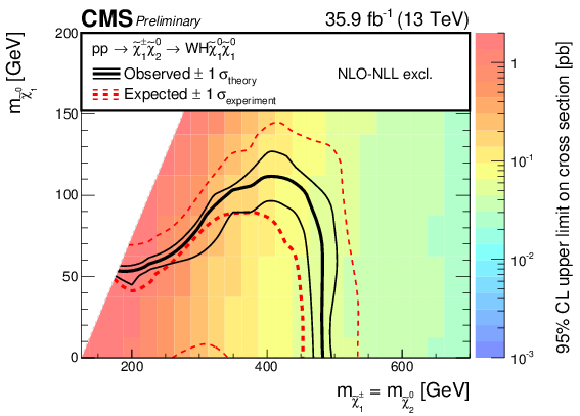
png pdf root |
Figure 8-b:
The 95% CL upper limits on the production cross sections in the plane of $ {m_{\tilde{\chi}^{\pm}_1}} $ and $ {m_{\tilde{\chi}^0_1}} $ for the models of $ {\tilde{\chi}^{\pm}_1 \tilde{\chi}^0_2 } $ production with the WH topology. The thick solid black (dashed red) curve represents the observed (expected) exclusion contour assuming the theory cross sections. The area below each curve is the excluded region. The thin dashed red line indicates the $ \pm 1 \sigma _{\mathrm {experiment}}$ uncertainty. The thin black lines show the effect of the theoretical uncertainties ($ \pm 1 \sigma _{\mathrm {theory}}$) on the signal cross section. The $z$ axis shows the observed limit at 95% CL on the signal production cross section. |

png pdf root |
Figure 8-c:
The 95% CL upper limits on the production cross sections in the plane of $ {m_{\tilde{\chi}^{\pm}_1}} $ and $ {m_{\tilde{\chi}^0_1}} $ for the models of $ {\tilde{\chi}^{\pm}_1 \tilde{\chi}^0_2 } $ production with the mixed topology with 50% branching fraction to each of WZ and WH. The thick solid black (dashed red) curve represents the observed (expected) exclusion contour assuming the theory cross sections. The area below each curve is the excluded region. The thin dashed red line indicates the $ \pm 1 \sigma _{\mathrm {experiment}}$ uncertainty. The thin black lines show the effect of the theoretical uncertainties ($ \pm 1 \sigma _{\mathrm {theory}}$) on the signal cross section. The $z$ axis shows the observed limit at 95% CL on the signal production cross section. |

png pdf |
Figure 9:
The analysis with the best expected exclusion limit at each point in the plane of $ {m_{\tilde{\chi}^{\pm}_1}} $ and $ {m_{\tilde{\chi}^0_1}} $ for the models of $ {\tilde{\chi}^{\pm}_1 \tilde{\chi}^0_2 } $ production with (top) the WZ topology, (middle) the WH topology, or (bottom) the mixed topology 50% branching fraction to each of WZ and WH. |

png pdf |
Figure 9-a:
The analysis with the best expected exclusion limit at each point in the plane of $ {m_{\tilde{\chi}^{\pm}_1}} $ and $ {m_{\tilde{\chi}^0_1}} $ for the models of $ {\tilde{\chi}^{\pm}_1 \tilde{\chi}^0_2 } $ production with the WZ topology. |
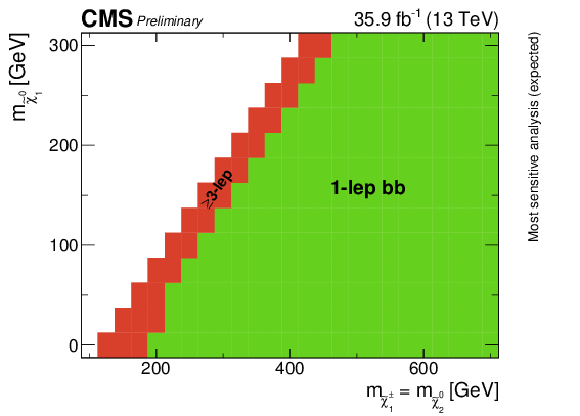
png pdf |
Figure 9-b:
The analysis with the best expected exclusion limit at each point in the plane of $ {m_{\tilde{\chi}^{\pm}_1}} $ and $ {m_{\tilde{\chi}^0_1}} $ for the models of $ {\tilde{\chi}^{\pm}_1 \tilde{\chi}^0_2 } $ production with the WH topology. |
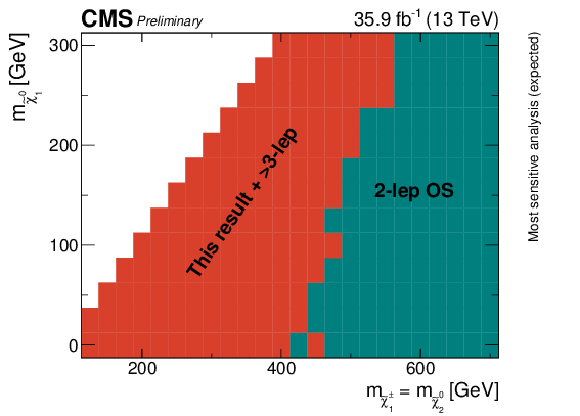
png pdf |
Figure 9-c:
The analysis with the best expected exclusion limit at each point in the plane of $ {m_{\tilde{\chi}^{\pm}_1}} $ and $ {m_{\tilde{\chi}^0_1}} $ for the models of $ {\tilde{\chi}^{\pm}_1 \tilde{\chi}^0_2 } $ production with the mixed topology 50% branching fraction to each of WZ and WH. |
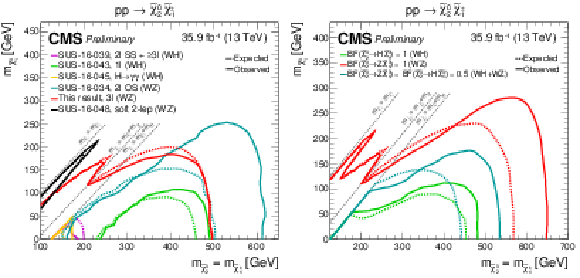
png pdf |
Figure 10:
Exclusion contours at the 95% CL in the plane of $ {m_{\tilde{\chi}^{\pm}_1}} $ and $ {m_{\tilde{\chi}^0_1}} $ for the models of $ {\tilde{\chi}^{\pm}_1 \tilde{\chi}^0_2 } $ production (left) for the individual analyses and (right) for the combination of analyses. The decay modes assumed for each contour are given in the legends. |
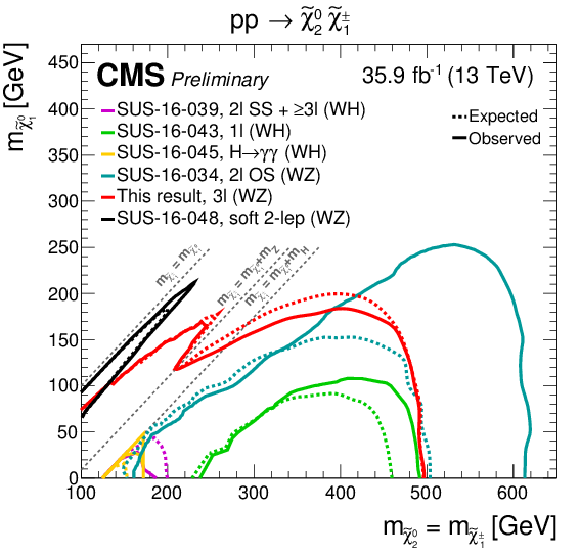
png pdf |
Figure 10-a:
Exclusion contours at the 95% CL in the plane of $ {m_{\tilde{\chi}^{\pm}_1}} $ and $ {m_{\tilde{\chi}^0_1}} $ for the models of $ {\tilde{\chi}^{\pm}_1 \tilde{\chi}^0_2 } $ production for the individual analyses. The decay modes assumed for each contour are given in the legends. |

png pdf |
Figure 10-b:
Exclusion contours at the 95% CL in the plane of $ {m_{\tilde{\chi}^{\pm}_1}} $ and $ {m_{\tilde{\chi}^0_1}} $ for the models of $ {\tilde{\chi}^{\pm}_1 \tilde{\chi}^0_2 } $ production for the combination of analyses. The decay modes assumed for each contour are given in the legends. |

png pdf root |
Figure 11:
Combined exclusion contours at the 95% CL in the plane of $ {m_{\tilde{\chi}^0_1}} $ and $ {\mathcal {B}(\tilde{\chi}^0_1 \to \mathrm{H} \tilde{\mathrm{G}})} $ for the model of $ {\tilde{\chi}^0_1 \tilde{\chi}^0_1} $ production. The area to the left of or below the solid (dashed) black curve represents the observed (expected) exclusion region. The green and yellow bands indicate the $\pm $1 and 2 standard deviation ($\sigma $) uncertainties in the expected limit. The thin black lines show the effect of the theoretical uncertainties ($ \pm $1$ \sigma _{\mathrm {theory}}$) on the signal cross section. |
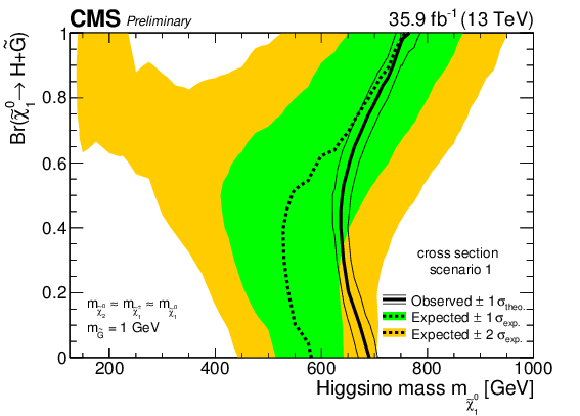
png pdf root |
Figure 11-a:
Combined exclusion contours at the 95% CL in the plane of $ {m_{\tilde{\chi}^0_1}} $ and $ {\mathcal {B}(\tilde{\chi}^0_1 \to \mathrm{H} \tilde{\mathrm{G}})} $ for the model of $ {\tilde{\chi}^0_1 \tilde{\chi}^0_1} $ production. The area to the left of or below the solid (dashed) black curve represents the observed (expected) exclusion region. The green and yellow bands indicate the $\pm $1 and 2 standard deviation ($\sigma $) uncertainties in the expected limit. The thin black lines show the effect of the theoretical uncertainties ($ \pm $1$ \sigma _{\mathrm {theory}}$) on the signal cross section. |
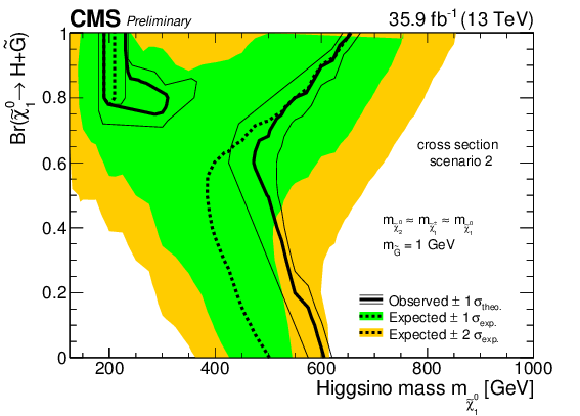
png pdf root |
Figure 11-b:
Combined exclusion contours at the 95% CL in the plane of $ {m_{\tilde{\chi}^0_1}} $ and $ {\mathcal {B}(\tilde{\chi}^0_1 \to \mathrm{H} \tilde{\mathrm{G}})} $ for the model of $ {\tilde{\chi}^0_1 \tilde{\chi}^0_1} $ production. The area to the left of or below the solid (dashed) black curve represents the observed (expected) exclusion region. The green and yellow bands indicate the $\pm $1 and 2 standard deviation ($\sigma $) uncertainties in the expected limit. The thin black lines show the effect of the theoretical uncertainties ($ \pm $1$ \sigma _{\mathrm {theory}}$) on the signal cross section. |
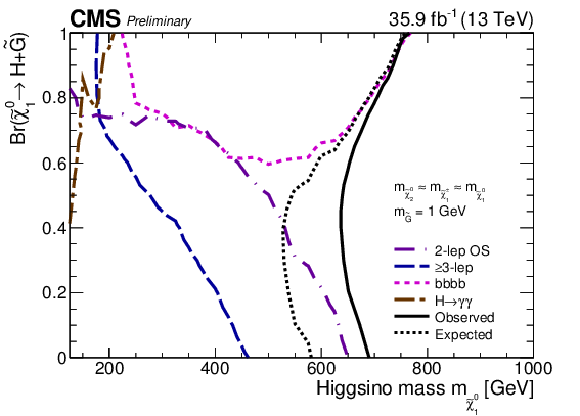
png pdf root |
Figure 12:
Observed exclusion contours at the 95% CL in the plane of $ {m_{\tilde{\chi}^0_1}} $ and $ {\mathcal {B}(\tilde{\chi}^0_1 \to \mathrm{H} \tilde{\mathrm{G}})} $ for the model of $ {\tilde{\chi}^0_1 \tilde{\chi}^0_1} $ production for each individual analysis compared with the combination. The 4b search drives the exclusion at large values of $ {\mathcal {B}(\tilde{\chi}^0_1 \to \mathrm{H} \tilde{\mathrm{G}})} $ while the on-Z dilepton search and the multilepton search search are competing at lower values of $ {\mathcal {B}(\tilde{\chi}^0_1 \to \mathrm{H} \tilde{\mathrm{G}})} $. |
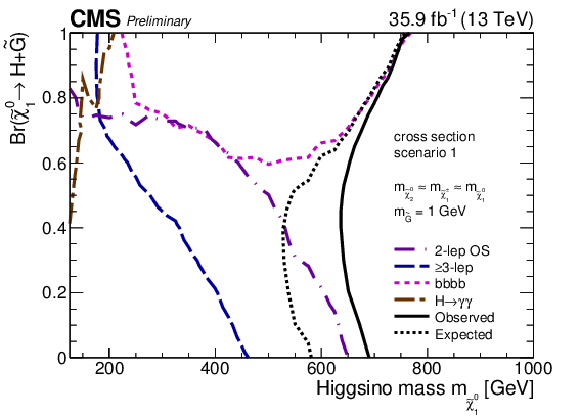
png pdf root |
Figure 12-a:
Observed exclusion contours at the 95% CL in the plane of $ {m_{\tilde{\chi}^0_1}} $ and $ {\mathcal {B}(\tilde{\chi}^0_1 \to \mathrm{H} \tilde{\mathrm{G}})} $ for the model of $ {\tilde{\chi}^0_1 \tilde{\chi}^0_1} $ production for each individual analysis compared with the combination. The 4b search drives the exclusion at large values of $ {\mathcal {B}(\tilde{\chi}^0_1 \to \mathrm{H} \tilde{\mathrm{G}})} $ while the on-Z dilepton search and the multilepton search search are competing at lower values of $ {\mathcal {B}(\tilde{\chi}^0_1 \to \mathrm{H} \tilde{\mathrm{G}})} $. |
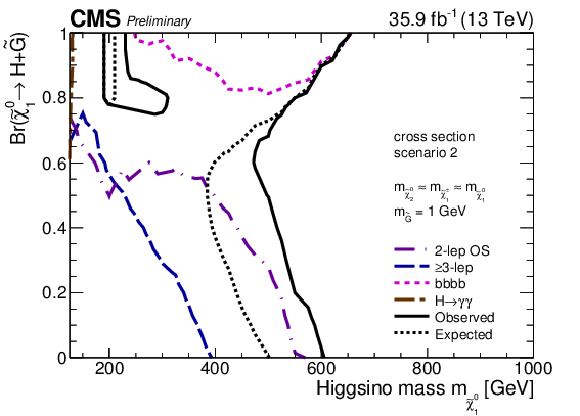
png pdf root |
Figure 12-b:
Observed exclusion contours at the 95% CL in the plane of $ {m_{\tilde{\chi}^0_1}} $ and $ {\mathcal {B}(\tilde{\chi}^0_1 \to \mathrm{H} \tilde{\mathrm{G}})} $ for the model of $ {\tilde{\chi}^0_1 \tilde{\chi}^0_1} $ production for each individual analysis compared with the combination. The 4b search drives the exclusion at large values of $ {\mathcal {B}(\tilde{\chi}^0_1 \to \mathrm{H} \tilde{\mathrm{G}})} $ while the on-Z dilepton search and the multilepton search search are competing at lower values of $ {\mathcal {B}(\tilde{\chi}^0_1 \to \mathrm{H} \tilde{\mathrm{G}})} $. |

png pdf |
Figure 13:
The analysis with the best expected exclusion limit at each point in the plane of $ {m_{\tilde{\chi}^0_1}} $ and $ {\mathcal {B}(\tilde{\chi}^0_1 \to \mathrm{H} \tilde{\mathrm{G}})} $ for the model of $ {\tilde{\chi}^0_1 \tilde{\chi}^0_1} $ production. |
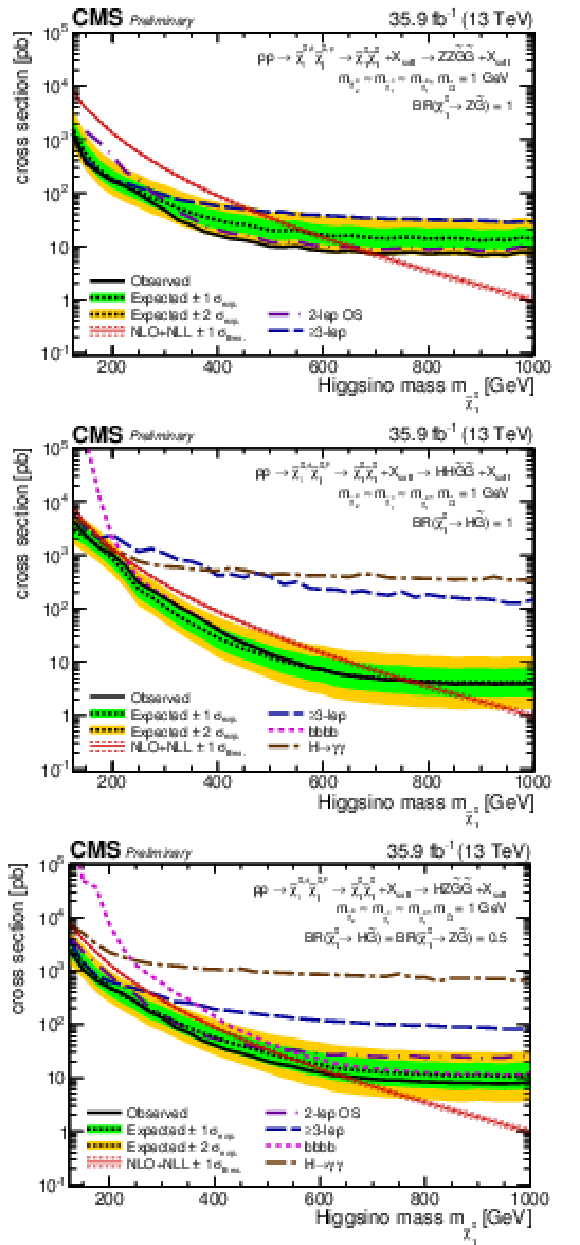
png pdf |
Figure 14:
The 95% CL upper limits on the production cross sections as a function of $ {m_{\tilde{\chi}^0_1}} $ for the model of $ {\tilde{\chi}^0_1 \tilde{\chi}^0_1} $ production with three choices of $ {\mathcal {B}(\tilde{\chi}^0_1 \to \mathrm{H} \tilde{\mathrm{G}})} $ : (top) 0%, yielding the ZZ topology, (middle) 100%, yielding the HH topology, and (bottom) 50%, yielding the WH mixed topology. The solid black line represents the observed exclusion. The dashed black line represents the expected exclusion, while the green and yellow bands indicate the $\pm $1 and 2 standard deviation ($\sigma $) uncertainties in the expected limit. The red lines shows the theoretical cross section with its uncertainty. The other lines in each plot show the observed exclusion for individual analyses. |
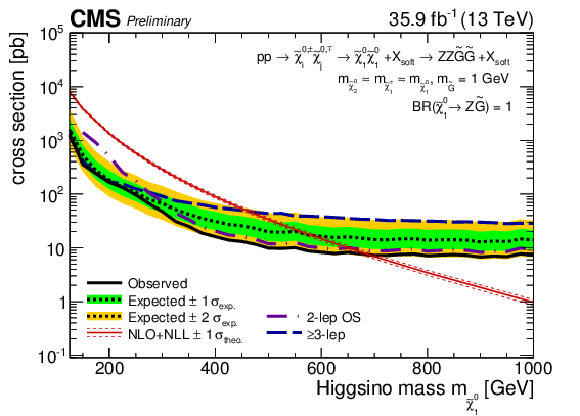
png pdf root |
Figure 14-a:
The 95% CL upper limits on the production cross sections as a function of $ {m_{\tilde{\chi}^0_1}} $ for the model of $ {\tilde{\chi}^0_1 \tilde{\chi}^0_1} $ production with three choices of $ {\mathcal {B}(\tilde{\chi}^0_1 \to \mathrm{H} \tilde{\mathrm{G}})} $ : 0%, yielding the ZZ topology. The solid black line represents the observed exclusion. The dashed black line represents the expected exclusion, while the green and yellow bands indicate the $\pm $1 and 2 standard deviation ($\sigma $) uncertainties in the expected limit. The red lines shows the theoretical cross section with its uncertainty. The other lines in each plot show the observed exclusion for individual analyses. |
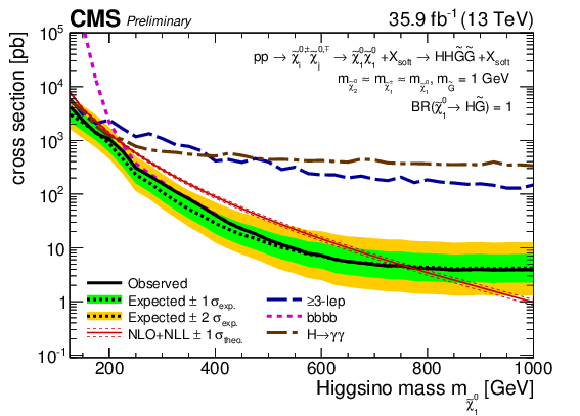
png pdf root |
Figure 14-b:
The 95% CL upper limits on the production cross sections as a function of $ {m_{\tilde{\chi}^0_1}} $ for the model of $ {\tilde{\chi}^0_1 \tilde{\chi}^0_1} $ production with three choices of $ {\mathcal {B}(\tilde{\chi}^0_1 \to \mathrm{H} \tilde{\mathrm{G}})} $ : 100%, yielding the HH topology. The solid black line represents the observed exclusion. The dashed black line represents the expected exclusion, while the green and yellow bands indicate the $\pm $1 and 2 standard deviation ($\sigma $) uncertainties in the expected limit. The red lines shows the theoretical cross section with its uncertainty. The other lines in each plot show the observed exclusion for individual analyses. |

png pdf root |
Figure 14-c:
The 95% CL upper limits on the production cross sections as a function of $ {m_{\tilde{\chi}^0_1}} $ for the model of $ {\tilde{\chi}^0_1 \tilde{\chi}^0_1} $ production with three choices of $ {\mathcal {B}(\tilde{\chi}^0_1 \to \mathrm{H} \tilde{\mathrm{G}})} $ : 50%, yielding the WH mixed topology. The solid black line represents the observed exclusion. The dashed black line represents the expected exclusion, while the green and yellow bands indicate the $\pm $1 and 2 standard deviation ($\sigma $) uncertainties in the expected limit. The red lines shows the theoretical cross section with its uncertainty. The other lines in each plot show the observed exclusion for individual analyses. |
| Tables | |

png pdf |
Table 1:
Summary of all experimental searches considered in the combination (rows), and the signal topologies for which each search is used in the combined results (columns). |
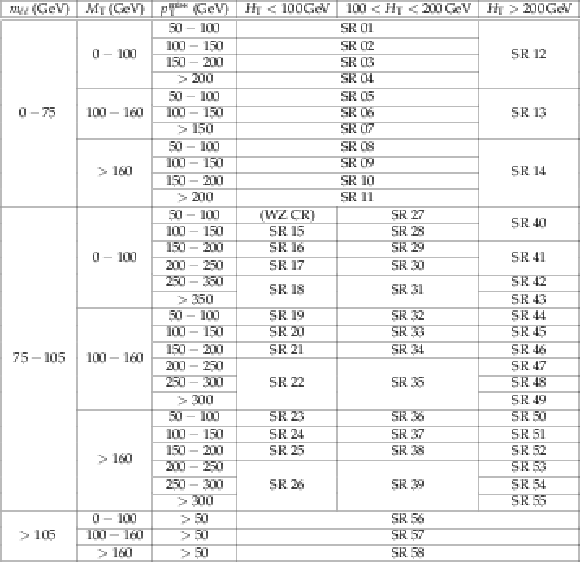
png pdf |
Table 2:
Definition of the search regions optimized for the WZ corridor region in the WZ signal topology. Events must have three leptons (e, $\mu$) forming at least one OSSF pair and they categorized in $ {m_{\ell \ell}} $, $ {M_\text {T}} $, $ {{p_{\mathrm {T}}} ^\text {miss}} $ and $ {H_{\mathrm {T}}} $. |

png pdf |
Table 3:
Expected and observed yields in the search regions. For each bin, the first number corresponds to the expected yield and its total uncertainty while the second number gives the observation. |
| Summary |
|
A number of searches for the electroweak production of charginos and neutralinos predicted in supersymmetry (SUSY) have been performed in different final states. All searches considered here use proton-proton collision data at $\sqrt{s} = $ 13 TeV, recorded with the CMS detector at the CERN LHC and corresponding to an integrated luminosity of 35.9 fb$^{-1}$. No significant deviations from the standard model expectation have been observed, as previously reported. An optimized search requiring three or more charged leptons (electrons or muons) has been presented, targeting chargino-neutralino production where the difference in mass between $ \tilde{\chi}^0_2 $ and $ \tilde{\chi}^0_1 $ is approximately equal to the mass of the Z boson, and no significant deviations from the standard model prediction are observed. This search is interpreted in a simplified model scenario of SUSY chargino-neutralino ($\tilde{\chi}^{\pm}_1 \tilde{\chi}^0_2 $) production with decays $\tilde{\chi}^{\pm}_1\to\mathrm{W}^{\pm}\tilde{\chi}^0_1$ and $ \tilde{\chi}^0_2 \to\mathrm{Z}\tilde{\chi}^0_1$, where $ \tilde{\chi}^0_1 $ is the lightest SUSY particle (LSP). In the targeted phase space, the expected and observed 95% confidence level exclusion limits extend to 255 GeV in the mass of $ \tilde{\chi}^0_2 $ and 125 GeV in the mass of $ \tilde{\chi}^0_1 $, improving the observed limits from the previous publication by up to 60 GeV [29]. A statistical combination of several searches is performed and interpreted in the context of simplified models of either chargino-neutralino production, or neutralino pair production in a gauge-mediated SUSY breaking (GMSB) scenario. For a massless LSP $ \tilde{\chi}^0_1 $ in the chargino-neutralino model, the combined result gives an observed (expected) limit in the $ \tilde{\chi}^{\pm}_1 $ mass of about 650 (570) GeV for the WZ topology, 480 (455) GeV for the WH topology, and 535 (440) GeV for the mixed topology. Compared to the results of individual analyses, the combination improves the observed exclusion limit by up to 40 GeV in the masses of $ \tilde{\chi}^{\pm}_1 $ and $ \tilde{\chi}^0_2 $ in the chargino-neutralino model. The combination also excludes intermediate mass values that were not excluded by individual analyses, including $ \tilde{\chi}^{\pm}_1 $ masses between 180 and 240 GeV in the WH topology. In the GMSB neutralino pair model, the combined result gives an observed (expected) limit in the $ \tilde{\chi}^0_1 $ mass of 650-750 (550-750) GeV. The combined result improves the observed limit by up to 200 GeV in the mass of $ \tilde{\chi}^0_1 $ in the GMSB neutralino pair model, depending on the branching fractions for the SUSY particle decays. |
| Additional Figures | |
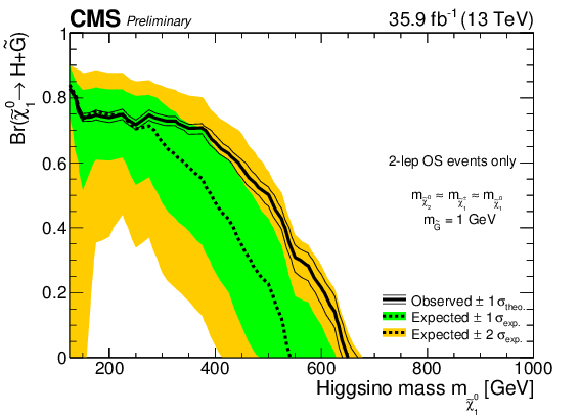
png pdf root |
Additional Figure 1:
Exclusion contours at the 95% CL for the model of neutralino-neutralino production for events obtained in the 2-lep OS analysis. |
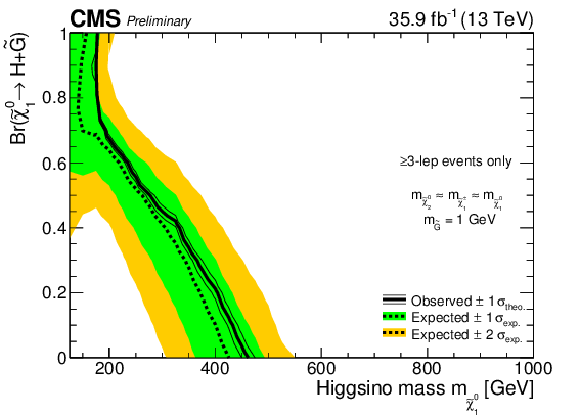
png pdf root |
Additional Figure 2:
Exclusion contours at the 95% CL for the model of neutralino-neutralino production for events obtained in the $\geq $3-lep analysis. |
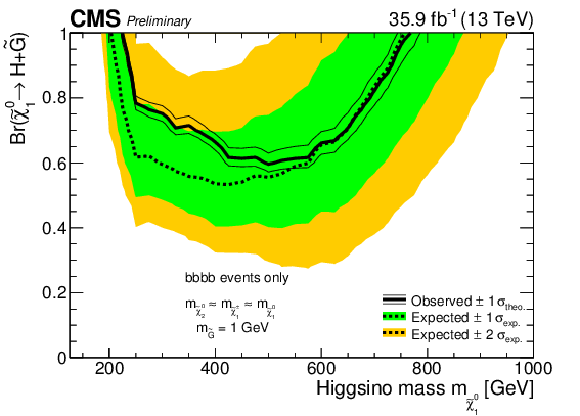
png pdf root |
Additional Figure 3:
Exclusion contours at the 95% CL for the model of neutralino-neutralino production for events obtained in the bbbb analysis. |
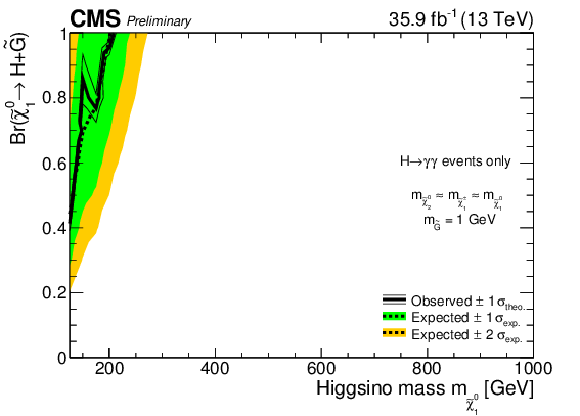
png pdf root |
Additional Figure 4:
Exclusion contours at the 95% CL for the model of neutralino-neutralino production for events obtained in the $\mathrm {H}\rightarrow \gamma \gamma $ analysis. |
| References | ||||
| 1 | P. Ramond | Dual theory for free fermions | PRD 3 (1971) 2415 | |
| 2 | Y. A. Golfand and E. P. Likhtman | Extension of the algebra of Poincare group generators and violation of P invariance | JEPTL 13 (1971)323 | |
| 3 | A. Neveu and J. H. Schwarz | Factorizable dual model of pions | NPB 31 (1971) 86 | |
| 4 | D. V. Volkov and V. P. Akulov | Possible universal neutrino interaction | JEPTL 16 (1972)438 | |
| 5 | J. Wess and B. Zumino | A Lagrangian model invariant under supergauge transformations | PLB 49 (1974) 52 | |
| 6 | J. Wess and B. Zumino | Supergauge transformations in four dimensions | NPB 70 (1974) 39 | |
| 7 | P. Fayet | Supergauge invariant extension of the Higgs mechanism and a model for the electron and its neutrino | NPB 90 (1975) 104 | |
| 8 | H. P. Nilles | Supersymmetry, supergravity and particle physics | Phys. Rep. 110 (1984) 1 | |
| 9 | A. Buras, J. Ellis, M. Gaillard, and D. Nanopoulos | Aspects of the grand unification of strong, weak and electromagnetic interactions | Nuclear Physics B 135 (1978) 66 | |
| 10 | H. Haber and G. Kane | The search for supersymmetry: Probing physics beyond the standard model | Phys. Rep. 117 (1985) 75 | |
| 11 | G. R. Farrar and P. Fayet | Phenomenology of the Production, Decay, and Detection of New Hadronic States Associated with Supersymmetry | PLB 76 (1978) 575 | |
| 12 | ATLAS Collaboration | Search for the electroweak production of supersymmetric particles in $ \sqrt{s}= $ 8 TeV pp collisions with the ATLAS detector | PRD 93 (2016) 052002 | 1509.07152 |
| 13 | ATLAS Collaboration | Search for photonic signatures of gauge-mediated supersymmetry in 8 TeV pp collisions with the ATLAS detector | PRD 92 (2015) 072001 | 1507.05493 |
| 14 | ATLAS Collaboration | Search for metastable heavy charged particles with large ionisation energy loss in pp collisions at $ \sqrt{s} = $ 8 TeV using the ATLAS experiment | EPJC 75 (2015) 407 | 1506.05332 |
| 15 | ATLAS Collaboration | Search for direct pair production of a chargino and a neutralino decaying to the 125 GeV Higgs boson in $ \sqrt{s} = $ 8 TeV pp collisions with the ATLAS detector | EPJC 75 (2015) 208 | 1501.07110 |
| 16 | ATLAS Collaboration | Searches for heavy long-lived charged particles with the ATLAS detector in proton-proton collisions at $ \sqrt{s} = $ 8 TeV | JHEP 01 (2015) 068 | 1411.6795 |
| 17 | ATLAS Collaboration | Search for nonpointing and delayed photons in the diphoton and missing transverse momentum final state in 8 TeV pp collisions at the LHC using the ATLAS detector | PRD 90 (2014) 112005 | 1409.5542 |
| 18 | ATLAS Collaboration | Search for the direct production of charginos, neutralinos and staus in final states with at least two hadronically decaying taus and missing transverse momentum in pp collisions at $ \sqrt{s} = $ 8 TeV with the ATLAS detector | JHEP 10 (2014) 096 | 1407.0350 |
| 19 | ATLAS Collaboration | Search for supersymmetry in events with four or more leptons in $ \sqrt{s} = $ 8 TeV pp collisions with the ATLAS detector | PRD 90 (2014) 052001 | 1405.5086 |
| 20 | ATLAS Collaboration | Search for direct production of charginos, neutralinos and sleptons in final states with two leptons and missing transverse momentum in pp collisions at $ \sqrt{s} = $ 8 TeV with the ATLAS detector | JHEP 05 (2014) 071 | 1403.5294 |
| 21 | ATLAS Collaboration | Search for direct production of charginos and neutralinos in events with three leptons and missing transverse momentum in $ \sqrt{s} = $ 8 TeV pp collisions with the ATLAS detector | JHEP 04 (2014) 169 | 1402.7029 |
| 22 | ATLAS Collaboration | Search for charginos nearly mass degenerate with the lightest neutralino based on a disappearing-track signature in pp collisions at $ \sqrt{s} = $ 8 TeV with the ATLAS detector | PRD 88 (2013) 112006 | 1310.3675 |
| 23 | CMS Collaboration | Searches for electroweak production of charginos, neutralinos, and sleptons decaying to leptons and W, Z, and Higgs bosons in pp collisions at 8 TeV | EPJC 74 (2014) 3036 | CMS-SUS-13-006 1405.7570 |
| 24 | CMS Collaboration | Searches for electroweak neutralino and chargino production in channels with Higgs, Z, and W bosons in pp collisions at 8 TeV | PRD 90 (2014) 092007 | CMS-SUS-14-002 1409.3168 |
| 25 | CMS Collaboration | Search for supersymmetry in electroweak production with photons and large missing transverse energy in pp collisions at $ \sqrt{s} = $ 8 TeV | PLB 759 (2016) 479 | CMS-SUS-14-016 1602.08772 |
| 26 | CMS Collaboration | Search for supersymmetry in events with soft leptons, low jet multiplicity, and missing transverse energy in proton-proton collisions at $ \sqrt{s} = $ 8 TeV | PLB 759 (2016) 9 | CMS-SUS-14-021 1512.08002 |
| 27 | CMS Collaboration | Search for supersymmetry in events with a photon, a lepton, and missing transverse momentum in pp collisions at $ \sqrt{s} = $ 8 TeV | PLB 757 (2016) 6 | CMS-SUS-14-013 1508.01218 |
| 28 | CMS Collaboration | Search for electroweak production of charginos in final states with two $ \tau $ leptons in pp collisions at $ \sqrt{s} = $ 8 TeV | JHEP 04 (2017) 018 | CMS-SUS-14-022 1610.04870 |
| 29 | CMS Collaboration | Search for electroweak production of charginos and neutralinos in multilepton final states in pp collision data at $ \sqrt{s}= $ 13 TeV | CMS-PAS-SUS-16-039 | CMS-PAS-SUS-16-039 |
| 30 | CMS Collaboration | Search for new physics in events with two low momentum opposite-sign leptons and missing transverse energy at $ \sqrt{s}= $ 13 TeV | CMS-PAS-SUS-16-048 | CMS-PAS-SUS-16-048 |
| 31 | CMS Collaboration | Search for Excess Higgs production in diphoton final states using the razor variables at $ \sqrt{s}= $ 13 TeV | CMS-PAS-SUS-16-045 | CMS-PAS-SUS-16-045 |
| 32 | CMS Collaboration | Search for the pair production of Higgsinos in pp collisions at $ \sqrt s = $ 13 TeV in final states with Higgs bosons and large missing transverse momentum | CMS-PAS-SUS-16-044 | CMS-PAS-SUS-16-044 |
| 33 | CMS Collaboration | Search for new physics in final states with two opposite-sign, same-flavor leptons, jets, and missing transverse momentum in pp collisions at $ \sqrt{s}= $ 13 TeV | CMS-PAS-SUS-16-034 | CMS-PAS-SUS-16-034 |
| 34 | CMS Collaboration | Search for electroweak production of charginos and neutralinos in the WH final state in proton-proton collisions at $ \sqrt{s}= $ 13 TeV | CMS-PAS-SUS-16-043 | CMS-PAS-SUS-16-043 |
| 35 | J. Alwall, P. Schuster, and N. Toro | Simplified models for a first characterization of new physics at the LHC | PRD 79 (2009) 075020 | 0810.3921 |
| 36 | J. Alwall, M.-P. Le, M. Lisanti, and J. G. Wacker | Model-independent jets plus missing energy searches | PRD 79 (2009) 015005 | 0809.3264 |
| 37 | D. Alves et al. | Simplified models for LHC new physics searches | JPG 39 (2012) 105005 | 1105.2838 |
| 38 | CMS Collaboration | Interpretation of searches for supersymmetry with simplified models | PRD 88 (2013) 052017 | CMS-SUS-11-016 1301.2175 |
| 39 | ATLAS and CMS Collaborations | Measurements of the Higgs boson production and decay rates and constraints on its couplings from a combined ATLAS and CMS analysis of the LHC pp collision data at $ \sqrt{s}= $ 7 and 8 TeV | JHEP 08 (2016) 045 | 1606.02266 |
| 40 | S. P. Martin | A Supersymmetry primer | , [Adv. Ser. Direct. High Energy Phys. 18, 1 (1998)] | hep-ph/9709356 |
| 41 | K. T. Matchev and S. D. Thomas | Higgs and Z boson signatures of supersymmetry | PRD 62 (2000) 077702 | hep-ph/9908482 |
| 42 | P. Meade, M. Reece, and D. Shih | Prompt decays of general neutralino NLSPs at the Tevatron | JHEP 05 (2010) 105 | 0911.4130 |
| 43 | J. T. Ruderman and D. Shih | General neutralino NLSPs at the early LHC | JHEP 08 (2012) 159 | 1103.6083 |
| 44 | B. Fuks, M. Klasen, D. R. Lamprea, and M. Rothering | Precision predictions for electroweak superpartner production at hadron colliders with Resummino | EPJC 73 (2013) 2480 | 1304.0790 |
| 45 | G. Bozzi, B. Fuks, and M. Klasen | Joint resummation for slepton pair production at hadron colliders | NPB 794 (2008) 46 | 0709.3057 |
| 46 | P. Z. Skands et al. | SUSY Les Houches accord: interfacing SUSY spectrum calculators, decay packages, and event generators | JHEP 07 (2004) 036 | hep-ph/0311123 |
| 47 | B. Fuks, M. Klasen, D. R. Lamprea, and M. Rothering | Gaugino production in proton-proton collisions at a center-of-mass energy of 8 TeV | JHEP 10 (2012) 081 | 1207.2159 |
| 48 | G. Bozzi, B. Fuks, and M. Klasen | Threshold Resummation for Slepton-Pair Production at Hadron Colliders | NPB 777 (2007) 157 | hep-ph/0701202 |
| 49 | G. Bozzi, B. Fuks, and M. Klasen | Transverse-momentum resummation for slepton-pair production at the CERN LHC | PRD 74 (2006) 015001 | hep-ph/0603074 |
| 50 | CMS Collaboration | The CMS experiment at the CERN LHC | JINST 3 (2008) S08004 | CMS-00-001 |
| 51 | CMS Collaboration | Particle-flow reconstruction and global event description with the CMS detector | Submitted to JINST | CMS-PRF-14-001 1706.04965 |
| 52 | M. Cacciari, G. P. Salam, and G. Soyez | The anti-$ {k_{\mathrm{T}}}\ $ jet clustering algorithm | JHEP 04 (2008) 063 | 0802.1189 |
| 53 | M. Cacciari, G. P. Salam, and G. Soyez | FastJet User Manual | EPJC 72 (2012) 1896 | 1111.6097 |
| 54 | CMS Collaboration | Missing transverse energy performance of the CMS detector | JINST 6 (2011) P09001 | CMS-JME-10-009 1106.5048 |
| 55 | CMS Collaboration | Performance of electron reconstruction and selection with the cms detector in proton-proton collisions at $ \sqrt{s} = $ 8 tev | JINST 10 (2015) P06005 | CMS-EGM-13-001 1502.02701 |
| 56 | CMS Collaboration | Performance of CMS muon reconstruction in pp collision events at $ \sqrt{s}= $ 7 TeV | JINST 7 (2012) P10002 | CMS-MUO-10-004 1206.4071 |
| 57 | CMS Collaboration | Reconstruction and identification of $ \tau $ lepton decays to hadrons and $ \nu_\tau $ at CMS | JINST 11 (2016) P01019 | CMS-TAU-14-001 1510.07488 |
| 58 | CMS Collaboration | Identification of b-quark jets with the CMS experiment | JINST 8 (2013) P04013 | CMS-BTV-12-001 1211.4462 |
| 59 | D. Guest et al. | Jet Flavor Classification in High-Energy Physics with Deep Neural Networks | PRD 94 (2016) 112002 | 1607.08633 |
| 60 | J. Alwall et al. | The automated computation of tree-level and next-to-leading order differential cross sections, and their matching to parton shower simulations | JHEP 07 (2014) 079 | 1405.0301 |
| 61 | T. Melia, P. Nason, R. Rontsch, and G. Zanderighi | W$ ^+ $W$ ^- $, WZ and ZZ production in the POWHEG BOX | JHEP 11 (2011) 078 | 1107.5051 |
| 62 | P. Nason and G. Zanderighi | $ \mathrm{W}^+ \mathrm{W}^- $, $ \mathrm{W} \mathrm{Z} $ and $ \mathrm{Z} \mathrm{Z} $ production in the POWHEG-BOX-V2 | EPJC 74 (2014) 2702 | 1311.1365 |
| 63 | NNPDF Collaboration | Parton distributions for the LHC Run II | JHEP 04 (2015) 040 | 1410.8849 |
| 64 | T. Sjostrand, S. Mrenna, and P. Z. Skands | A Brief Introduction to PYTHIA 8.1 | CPC 178 (2008) 852 | 0710.3820 |
| 65 | CMS Collaboration | Event generator tunes obtained from underlying event and multiparton scattering measurements | EPJC 76 (2016) 155 | CMS-GEN-14-001 1512.00815 |
| 66 | J. Alwall et al. | Comparative study of various algorithms for the merging of parton showers and matrix elements in hadronic collisions | EPJC 53 (2008) 473 | 0706.2569 |
| 67 | R. Frederix and S. Frixione | Merging meets matching in MC@NLO | JHEP 12 (2012) 061 | 1209.6215 |
| 68 | S. Alioli, P. Nason, C. Oleari, and E. Re | NLO single-top production matched with shower in POWHEG: s- and t-channel contributions | JHEP 11 (2010) 111 | 0907.4076v2 |
| 69 | E. Re | Single-top Wt-channel production matched with parton showers using the POWHEG method | EPJC 71 (2011) 1547 | 1009.2450 |
| 70 | R. Gavin, Y. Li, F. Petriello, and S. Quackenbush | FEWZ 2.0: A code for hadronic Z production at next-to-next-to-leading order | CPC 182 (2011) 2388 | 1011.3540 |
| 71 | R. Gavin, Y. Li, F. Petriello, and S. Quackenbush | W Physics at the LHC with FEWZ 2.1 | CPC 184 (2013) 208 | 1201.5896 |
| 72 | M. Czakon and A. Mitov | Top++: A Program for the Calculation of the Top-Pair Cross-Section at Hadron Colliders | CPC 185 (2014) 2930 | 1112.5675 |
| 73 | C. Borschensky et al. | Squark and gluino production cross sections in pp collisions at $ \sqrt{s} = $ 13, 14, 33 and 100 TeV | EPJC 74 (2014) 3174 | 1407.5066 |
| 74 | CMS Collaboration | Search for top-squark pair production in the single-lepton final state in pp collisions at $ \sqrt{s} = $ 8 TeV | EPJC 73 (2013) 2677 | CMS-SUS-13-011 1308.1586 |
| 75 | GEANT4 Collaboration | GEANT4---a simulation toolkit | NIMA 506 (2003) 250 | |
| 76 | S. Abdullin et al. | The fast simulation of the CMS detector at LHC | J. Phys. Conf. Ser. 331 (2011) 032049 | |
| 77 | CMS Collaboration | Inclusive search for supersymmetry using the razor variables in pp collisions at $ \sqrt{s} = $ 7 TeV | PRL 111 (2013) 081802 | CMS-SUS-11-024 1212.6961 |
| 78 | CMS Collaboration | Search for supersymmetry with razor variables in pp collisions at $ \sqrt{s} = $ 7 TeV | PRD 90 (2014) 112001 | CMS-SUS-12-005 1405.3961 |
| 79 | CMS Collaboration | Search for new physics in same-sign dilepton events in proton-proton collisions at $ \sqrt{s} = $ 13 TeV | EPJC 76 (2016) 439 | CMS-SUS-15-008 1605.03171 |
| 80 | A. L. Read | Presentation of search results: The cl$ _\mathrm{s} $ technique | JPG 28 (2002) 2693 | |
| 81 | T. Junk | Confidence level computation for combining searches with small statistics | NIMA 434 (1999) 435 | hep-ex/9902006 |
| 82 | G. Cowan, K. Cranmer, E. Gross, and O. Vitells | Asymptotic formulae for likelihood-based tests of new physics | EPJC 71 (2011) 1554 | 1007.1727 |
| 83 | ATLAS and CMS Collaborations | Procedure for the LHC Higgs boson search combination in summer 2011 | CMS-NOTE-2011-005 | |

|
Compact Muon Solenoid LHC, CERN |

|

|

|

|

|

|